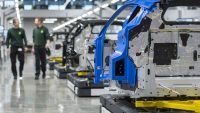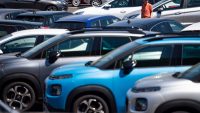JLR has revealed its latest tool to give customers the most luxurious driving experience – seat robots.
Called KUKA Occubots, the four dedicated robots are being used to simulate a decade of sitting, moving and twisting in a just matter of days.
They can exert forces more than 800 Newtons (N) (approximately 82kg) on each seat design 25,000 times over a period of around five days.
The Occubots also review the resilience of the vehicles’ heated seats.
Across 20,000 cycles over 25 days, a robot reenacts actions such as sliding and twisting in the seat, applying huge forces ranging from 350N to 700N to ensure the heated seat is robust and will remain operational throughout a vehicle’s lifespan.
Integrated sensors in the robot track torque hundreds of times per second to ensure forces are maintained during different tests, while a camera communicates with the Occubots to take regular photos to operate 24/7, independently reviewing progress and investigating failures.
The robots, which also test how quickly foam recovers it shape following pressure from different body types.
Thomas Mueller, JLR executive director, product engineering, said: ‘Settling into your seat is one of the first experiences when entering one of our vehicles.
‘Comfort is critical to luxury, so it’s a make-or-break moment for our clients and they expect a consistently comfortable ride over the life of their vehicle.
‘We’ve invested in robots to work alongside our expert engineers and rigorously test every aspect of our seat materials in super quick time. Automation like this is a vital part of our comprehensive vehicle quality component testing programme, which helps us review vehicle elements over a lifetime of usage and in the most extreme environments.’
The seating testing regime is part of the British luxury brand’s wider £18bn Reimagine strategy, with its Gaydon home being the base for a wide range of testing facilities including vehicle simulators, cold weather climate chambers and a semi‑anechoic chamber.

































